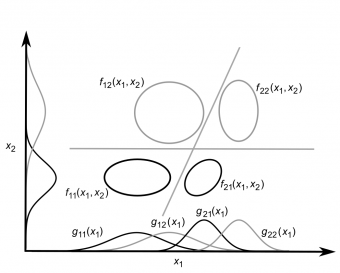
General Recognition Theory (GRT)
Signal detection theory, which was developed in the 1950’s, revolutionized psychophysics. Dr. Ashby played a lead role in developing a multidimensional version of signal detection theory called general recognition theory (GRT). The first three GRT publications were Ashby and Townsend (1986, Psychological Review), Ashby and Gott (1988, Journal of Experimental Psychology:Learning, Memory, & Cognition), and Ashby and Perrin (1988, Psychological Review).
Adding extra sensory dimensions to signal detection theory creates a number of new conceptual challenges and greatly increases the potential applicability of the model. The Ashby and Townsend (1986) paper focused on sensory and perceptual processes, the Ashby and Gott (1988) paper focused on decision processes, and the Ashby and Perrin (1988) paper focused on perceived similarity.
Before GRT, the literature included many terms that attempted to describe perceptual interactions among separate stimulus components, but none of these were rigorously defined or possessed clear underlying theoretical foundation. Included in this list were perceptual independence, perceptual separability vs. integrality, performance parity, and sampling independence. The 1986 paper made two fundamental contributions. First, it rigorously defined perceptual independence, perceptual separability, and decisional separability as the core interaction-related phenomena, and second, it showed exactly how the many terms that were then in use are related to each other through these core concepts.
Equally important to the theoretical concepts were a number of experimentally observable statistics which enable the scientist to assess the truth or falsity of the various theory-derived hypotheses. These can be classified into a group of non-parametric tests as opposed to assays that are associated with classical probability laws, such as multivariate Gaussian distributions. Of course, the former permit adjudication of central questions in ways that are general across the immense range of probability distributions. The latter permit valuable interpretation and linkage with not only traditional signal detection theory (e.g, Green & Swets, 1966) but facilitate connections with classic terms and concepts in psychometrics.
Worldwide, hundreds of articles have now been published on GRT, and it continues to be an area of intense research. Furthermore, the GRT definitions of perceptual independence, perceptual separability, and decisional separability are now all standard within the field of perception.

